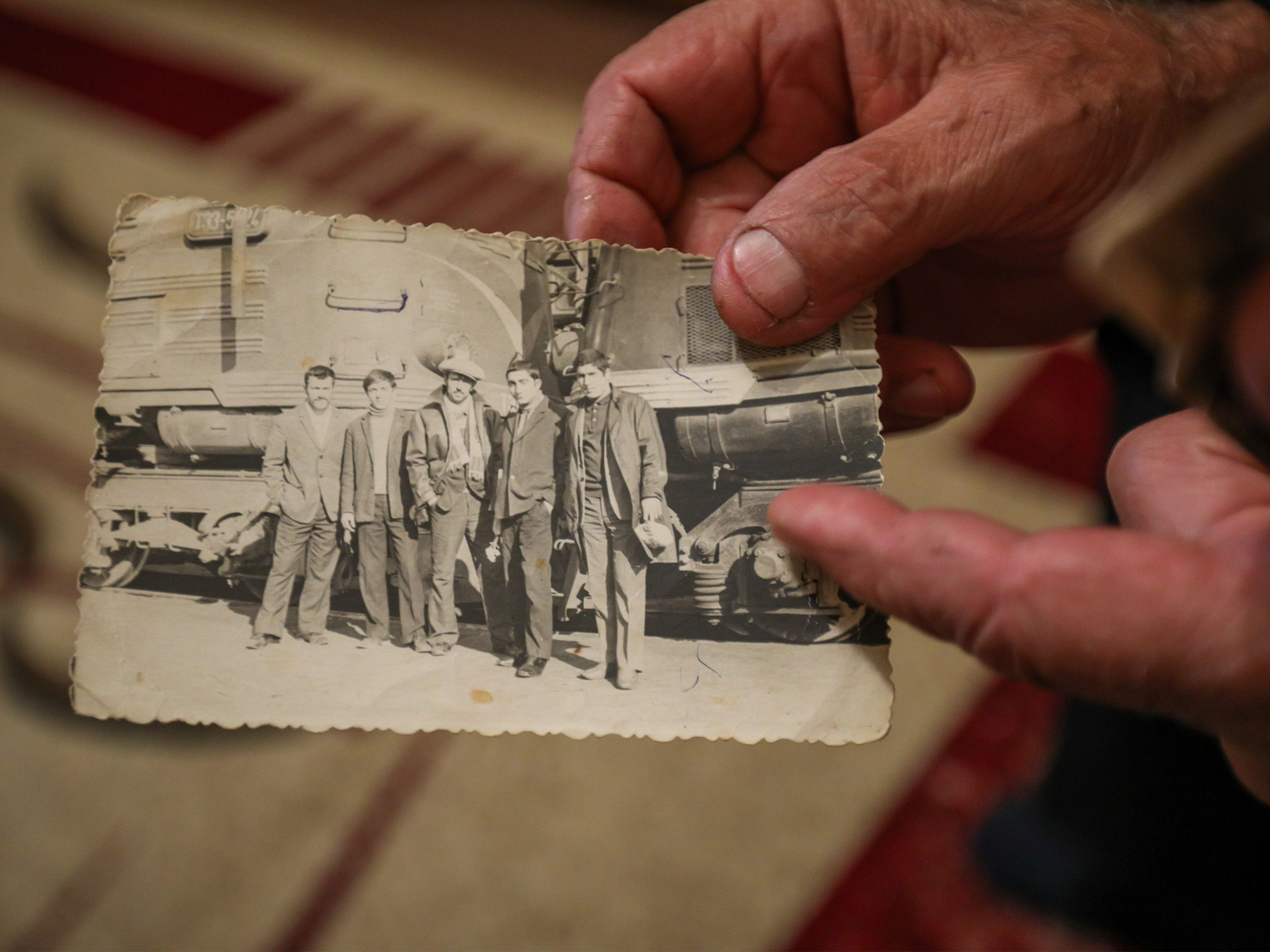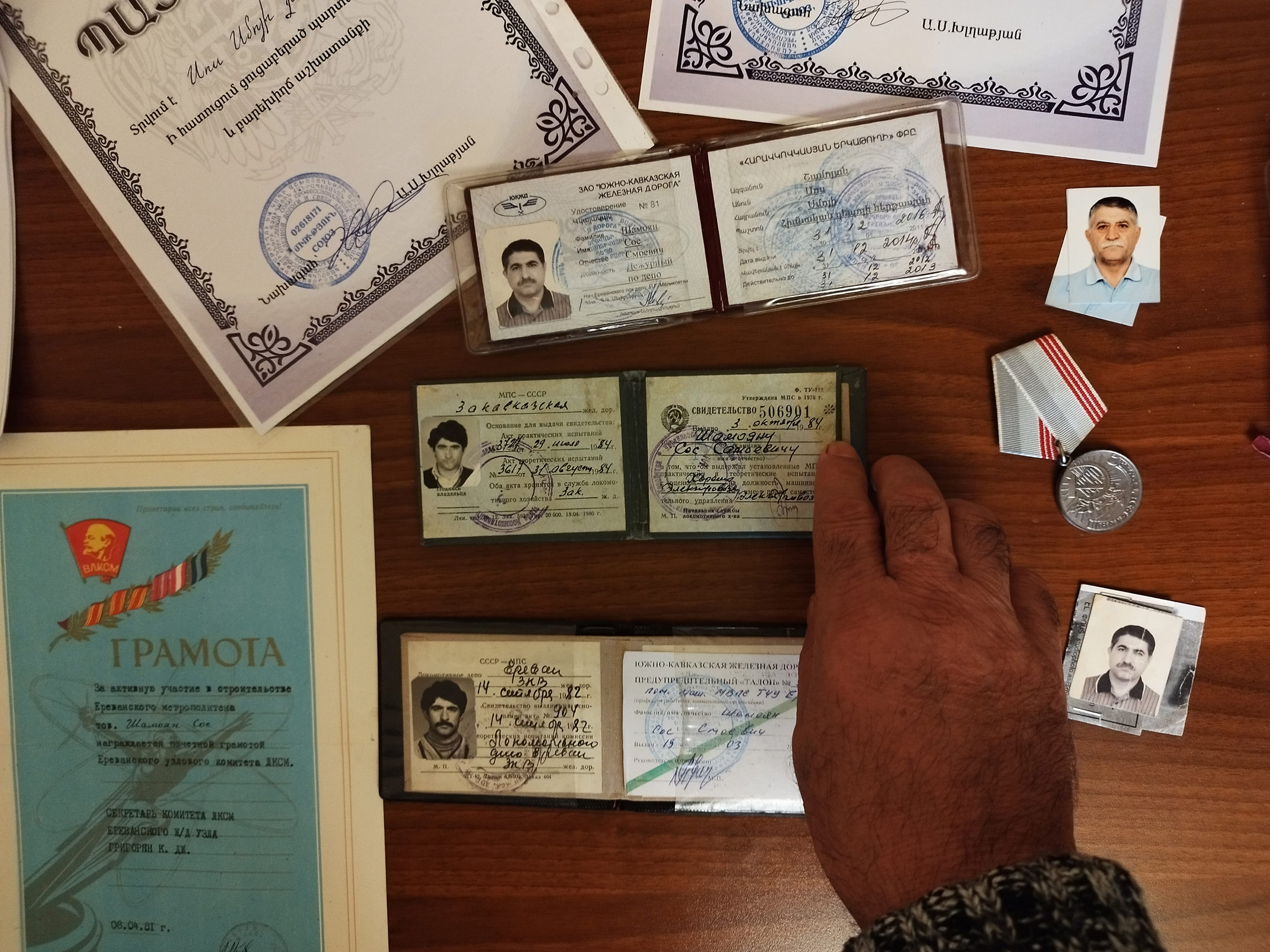Plans to rebuild Armenia-Azerbaijan railway stir hope, misgivings
An ambitious plan to restore train travel between Armenia and Azerbaijan for the first time in 30 years has raised hopes of economic growth—and fears of renewed conflict.
In their youth, Fakhraddin Mirzaliyev, 73, and Sos Shamoyan, 66, may have crossed paths as the trains they drove crisscrossed the Soviet republics of Armenia and Azerbaijan.

Fakhraddin Mirzaliyev’s archive
Fakhraddin Mirzaliyev, 73, spent his entire career on the railway. He said before the first Karabakh war, ethnic Azerbaijani train workers would stay in Armenian cities along the routes. “I spoke a little Armenian and understood them pretty well.”

Sos Shamoyan’s archive
Sos Shamoyan, 66, started working for the railway in 1978, first as a locksmith before working his way up to the conductor. He remembers good relations with his Azerbaijani colleagues until 1988. “We would celebrate their birthdays with them.”
The two men were part of the huge Soviet railway system, a critical infrastructure that moved people and goods through the two countries and on to neighboring Georgia and Russia. Ethnic Armenians and Azerbaijanis lived together in both countries, and everyone depended on the trains.
At that time, there were two railway lines that linked Armenia and Azerbaijan. One, known as the northern railway, traveled from the Armenian town of Ijevan to Gazakh in Azerbaijan. The second, known as the southern railway, ran from Eraskh, Armenia to Nakhchivan, before heading to Megri and Baku in Azerbaijan.

Fakhraddin was injured during the first Karabakh war when bombs hit the train he was driving in 1990. “[Shelling] turned into a sort of everyday thing starting in 1988,” he said, recalling one incident when a shrapnel hit his back at a station where Azerbaijanis traveling to Baku would catch the train.

Today Fakhraddin is retired but he still remembers the route he drove from Baku to Minjivan, in southern Azerbaijan.
“I drove passenger trains from Baku to Nakhchivan for 21 years,” recalls Fakhraddin, an Azerbaijani who retired from the railway when he turned 65.
Sos, an ethnic Yezidi from Armenia, remembers peaceful times when Armenians and Azerbaijanis used the trains together. “People would bring their goods from Nakhchivan to sell in Armenia, the Azerbaijanis who studied in Yerevan would travel back home on the weekends,” he says.
In the years leading up to the conflict, which began to heat up in the late 1980s, both men noted an increase in violence, however.
“It was all fine till Sumgait (A deadly attack on ethnic Armenians in the seaside town of Sumgait, Azerbaijan on February 27-March 1, 1988.),” Sos says. “We worked with Azerbaijanis on the railway, there were chaikhanas (traditional tea houses) near the railway in Norashen (a district in Nakhchivan now called Sharur), and there were coffee bars, restaurants, all very cheap. We would go together, we would celebrate their birthdays with them”.
By late 1989 there were almost no people crossing the border between Armenia and Azerbaijan, Sos notes—he says Azerbaijanis only traveled on the trains coming from Baku and going to Nakhchivan through Armenia.

Sos recalls that by 1989, there was practically no passenger traffic across the border between the two countries. He and his colleagues would drive nearly empty trains to Nakhchivan to bring aid to families displaced by the 1988 earthquake in Gyumri.

Later, Sos says two lines of police used to guard the railway station to protect the railway workers during violent anti-Armenian demonstrations. His friend was stabbed when he tried to fix something on the train and Sos was once bound and beaten. “I feel awful remembering that stuff, too many things happened.”
“[Shelling] became a sort of everyday thing starting in 1988,” recalls Fakhraddin, who remembered three especially dangerous incidents. In 1990, he was driving a train full of people when the bombing started. “I ran off to the rails. I got a shrapnel wound in my back. I was lucky because it first hit a column, lessening the impact.
Both lines ceased operating in the 1990s, when Armenia and Azerbaijan fought the first war over Nagorno Karabakh (commonly called Artsakh by Armenians). Today, however, there are plans to rebuild the southern line, reopening train traffic between the two countries for the first time in decades. The plans, part of the peace settlement that ended the second war over Karabakh in 2020, could provide a major economic boost to both countries, allowing trade to flow freely through the two countries and onto neighboring Iran and Turkey.
But the recent history of conflict, memories of atrocities on both sides, lack of trust and high cost could make it difficult to complete the project.
Before the conflict started in the late 1980s, Syunik, a southern region of Armenia, known as Zangazur in Azerbaijan—was a critical link in the southern railway.
With the first Karabakh War, railway travel in this section stopped. The Azerbaijani districts in Karabakh near the Iranian border — Gubadli, Zangilan, Jabrayil and a part of the Fuzuli district—came under the control of Armenian forces. The railway tracks were dismantled.

If the railway reopens, it could provide a unique opportunity for both countries’ economies.
In May 2022, work to rebuild the 110.4 km-Horadiz-Agband railway along the southern border of Azerbaijan with Iran in the Karabakh region began. It is the first step of the implementation of the so-called Zangazur corridor project, which is supposed to connect Azerbaijan to Nakhchivan via Armenia. According to official documents, 312.7 million AZN [$183.9 million] have been allocated to rebuild this railway, which includes nine stations. The two countries already established working groups to continue the reconstruction process, although work has not started yet on the Armenian side. Armenia’s vice-minister Mger Grigoryan said $200 million is needed to build the railway given the period of three years.
Arzu Abdullaeva, a pioneer peacebuilder, thinks the project is advantageous for all regional countries, including major powers such as Iran, Turkey, and Russia.
"However, there must be a political will. That is important. This railway is important in terms of international transportation. It looks like an ideal perspective… if there is a will, if no one creates obstacles and if politics doesn't get favored over economics. If politics dominates human life and morality, then this corridor, these relations not only do not make sense, but can even turn into a war zone,” Abdullaeva says.
Arman Grigoryan, an Armenian political scientist, says the fear of reopening train traffic in both societies is very rational taking into consideration the decades of enmity, which won’t disappear in a day. He underlines however that reopening the railway would be economically beneficial for both sides.
“Assuring the security of the people would be hard, but I think it is a solvable problem if there is a political will. The guarantee of the security should be a third party, as Armenia and Azerbaijan even in the case of signing a peace agreement won’t have the level of trust in each other to be able to be the guarantors themselves,” he says, adding however that ‘limitation of sovereignty’ and ‘opening railway links’ are two different things.
“Many in Azerbaijan talk about a corridor that from their point of view should have extraterritorial status, on which Armenia wouldn’t have any control. This option is not beneficial to Armenia, of course, this would mean limiting the sovereignty of Armenia. [However] It’s very obvious that opening railway links would be beneficial to Armenia as well. For 30 years we have been complaining about the blockade and the price our economy paid because of that blockade.”
Armenian train conductor, Sos, is uncertain about the future.
“I saw peaceful times, but I can’t imagine if that would ever be possible again, I can’t see a solution after all this,” he says. “If anyone asks me why these children died, I cannot answer.”
Azerbaijani Fakhraddin is more optimistic, however. He believes the railway “will function again, it is inevitable.”
This article was produced in the framework of Chai Khana Fellowship program - Summer/Autumn 2022
This article was prepared with support from the Friedrich-Ebert-Stiftung (FES) South Caucasus Regional Office. All opinions expressed are the author’s alone, and do not necessarily reflect the views of FES.
The networking event and the mentorship of the fellows was supported by the Federal Foreign Office and the Civil Society Cooperation program, implemented by the Deutsche Gesellschaft e. V.
DONATE NOW

